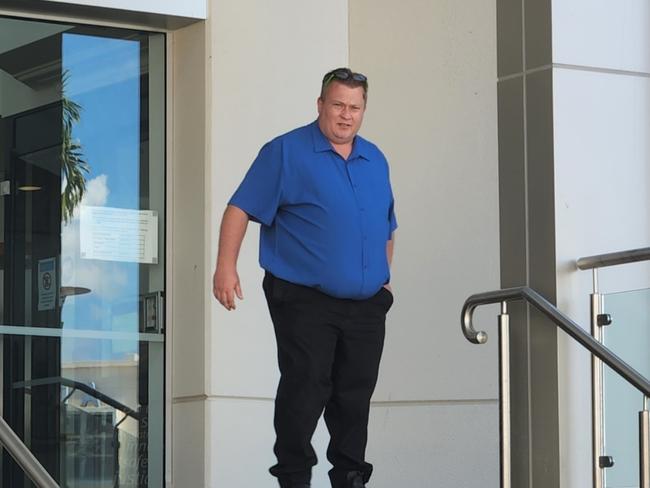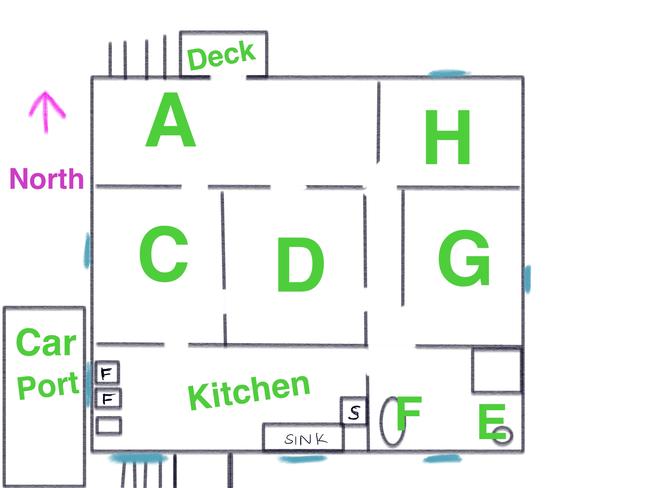Fire investigator gives evidence in Craig Paul Carrington’s alleged arson and attempted fraud trial
Fire investigators found tins of paint, paint thinners and two petrol cans among the debris of a house fire at the centre of an alleged arson case. Read more here.

Police & Courts
Don't miss out on the headlines from Police & Courts. Followed categories will be added to My News.
Fire investigators found tins of paint and paint thinners, along with two petrol cans, toilet paper rolls, a phone book, mats, mosquito coils, a box of matches and remnants of cupboards among the debris of Craig Paul Carrington’s house, which he is accused of setting on fire, a court has heard.
Mr Carrington’s Bedford Street, Berserker, house was damaged in a fire on August 8, 2020.
He had a $150,000 insurance policy on the house with Allianz, for which he lodged a claim, attempting to get a payout from the policy.
Mr Carrington was later charged with one count of arson and one of attempted fraud, to which he has pleaded not guilty this week in a trial in Rockhampton District Court.
Queensland Police Service fire investigator Sergeant Rebecca Bennett gave evidence about what she found in her investigations of the fire during Mr Carrington’s trial.

The court heard the back of Mr Carrington’s house was at the southern end of the building.
Sergeant Bennett said she observed there was not a lot of “significant damage” to the exterior of the house, except for under the eaves on the western and southern sides.
She said several windows had glass missing due to the fire and two had black residue of something that had covered the window before the fire.
Sergeant Bennett said the room with the most significant damage was the kitchen, that went into the room marked C on the diagram, with the rest of the rooms only having smoke damage.
She said along the western side of the kitchen was where the most significant damage was.
Sergeant Bennett said the damage extended through the ceiling.
“When it comes to fires, they spread outwards and upwards,” she said.
“It’s not uncommon for fires to spread.
“So the entire ceiling was consumed and collapsed in places and you could see charring on the trusses in the roof on the north wall, which is the wall connecting (rooms) D and C.
“There were areas of that wall where the fire had consumed small parts of the wall at the top, so it was going through to the next room.”
Sergeant Bennett said using fire patterns and fire effects, she was able to determine the origin area of the fire, but not a specific point of origin.
She explained the area of origin was where the two Fs in the diagram were and that was where a full fridge and freezer stood side-by-side.
Sergeant Bennett said both had materials stored on top and in front of them.
“The area of origin, I determined, was either on top of the fridge and freezer or at the front of the fridge or freezer,” she said.
Sergeant Bennett said fire debris located had remnants of a wooden cabinet which stored tins of paints and paint thinners, mats, a phone book, some toilet rolls, remnants of a curtain and rod, along with a metal fuel can which contained an opaque and hardened substance.
She said she also found a matchbox between the appliances and the wooden shelves to the side of the appliances.

Sergeant Bennett said on top of the appliances, she found remnants of the curtain, another fuel can that did not contain any detectable substances post-fire (she explained it could have contained a substance that evaporated due to the fire), several mats, mosquito coils, toilet rolls, a long lighter used for lighting barbecues and an aerosol can.
She said she also found the remains of a power board to which the remnants of the freezer plug were situated next to, and the power board remnants were traced back to a power outlet in the wall.
Sergeant Bennett said the fridge power plug was found dangling on the side of the appliance.
She said there was no fire damage to the back of the appliances, nor inside, ruling out faults in an appliance as the cause of the fire.
Sergeant Bennett said what could have happened was either the fire started on the floor and after spreading upwards, ignited the material on top; or it could have started on top of the appliances with fire falling down onto the floor.
She said on the other side of the room, there was a gas stove of which the grill door was down and the plastic from the six knobs on the unit had melted down onto the grill lid.
Sergeant Bennett said she was able to determine some of the knobs were turned into ‘on’ positions but was unable to determine if the stove had been hooked up to gas at the time of the fire.
She said in the middle of room C, she found a used matchstick with the wooden part not charred, along with the smoke detector which had no batteries.
Sergeant Bennett explained how, during her investigation, she ruled out possible causes of the fire based on five categories: natural events such as lightning strikes, electrical faults, mechanical such as sparks from a grinder, spontaneous combustion from chemical reactions of chemicals normally stored in sheds and human involvement – either accidental like a lit candle falling over, or deliberate.
She said she checked the Bureau of Meteorology’s weather report from the day of the fire and ruled out a natural event.
Sergeant Bennett said she could not find any mechanical items inside the house that could have caused a fire, so that category was ruled out.
However, she said she could not rule out the spontaneous combustion category, which usually occurs when there is a chemical or biological reaction that can cause heat.
Sergeant Bennett said that was found inside houses where people were cleaning and storing piles of rags containing flammable substances such as linseed oil and cleaning chemicals and there was nowhere for heat to go.
“In this case, I saw nothing to suggest that was the cause,” she said.
“I think it’s an unlikely cause but due to the fact that I don’t know every single item stored on top of that freezer and at the bottom … and there always could be material that has been wholly consumed (by the fire) … so I haven’t eliminated it as a possible cause.”
Sergeant Bennett said while there was no evidence of an electrical fault in the fridge or freezer, the power board could have been a cause.
She said while she did not see any evidence indicating it was an electrical cause, evidence could have been burned by the fire.
Sergeant Bennett said when looking at human involvement, people were usually aware if they accidentally started a fire.
“There are indications which we do look for in relation to deliberate human involvement,” she said.
Sergeant Bennett said that included the presence of petrol and other flammable liquids, such as those found in the origin area, or within substances such as paint thinner in the origin area, along with fuel-type items such as toilet rolls and a phone book, mosquito coils and mats.
She said these indications alone did not mean a person had deliberately lit a fire, but added up with other evidence, could support deliberate involvement more than accidental.
Sergeant Bennett pointed out the house “was largely empty”, apart from some kitchen utensils on the other side of the room and “large items like beds” in other rooms, along with a melted microwave, but there was a pile of flammable chemicals and fire fuels stacked up around the fridge and freezer.
She said this fire had several seats – locations where it likely started – with one on top of the appliances and one in front of the appliances.
“Having several seats of fire is also an indication of deliberate over accidental because it’s very unlikely that more than one area will be lit at the same time accidentally,” Sergeant Bennett said.
Under cross-examination by Mr Carrington’s barrister Sheridan Shaw, Sergeant Bennett told the court the tins of paint and paint thinner had erupted during the fire at the point of origin because “they were all over my shoes”.
The court heard Sergeant Bennett had written in her investigation report “the presence of fuel containers within the area of origin and the positioning of the matches … is unusual and supports deliberate human involvement in the cause of the fire”.
The trial continues.




